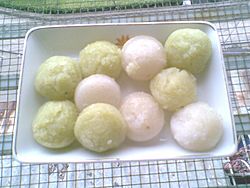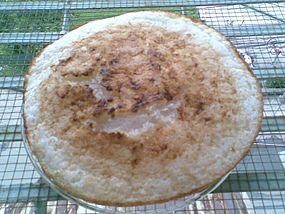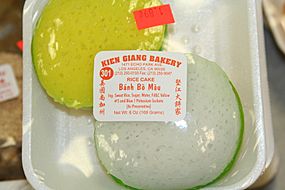Bánh bò facts for kids

Bánh bò hấp (steamed bánh bò)
|
|
| Type | Sponge cake |
|---|---|
| Course | Dessert |
| Place of origin | Vietnam |
| Region or state | Southeast Asia |
| Main ingredients | Rice flour, water, sugar, yeast, coconut milk |
| Similar dishes | Htanthi mont, Fa gao |
Bánh bò (literally "cow cake" or "crawl cake") is a sweet, chewy sponge cake from Vietnam. It is made from rice flour, water, sugar, and yeast, and has a honeycomb-like appearance (called rễ tre, literally "bamboo roots," in Vietnamese) on the inside due to the presence of numerous small air bubbles. Coconut milk is also usually a part of the batter, imparting a slight flavor and aroma of coconut. The cake is of Southern Chinese origin, although the Chinese version, called bái táng gāo (白糖糕), does not contain coconut milk. Bánh bò are generally eaten as a dessert, although they may also be consumed as an accompaniment to a meal.
Etymology
In the Vietnamese language, bánh means "cake", and bò can either mean "cow" or "to crawl". According to the entry for "𤙭" (bò) in Paulus Huỳnh Tịnh Của's 1895 dictionary Đại Nam quấc âm tự vị, the dessert is named for its resemblance to a cow's udder, implying that the name was shortened from bánh vú bò. However, according to a popular folk etymology, bò refers to how the cake "crawls" up to the rim of the bowl when steamed to completion.
Bánh bò is to be distinguished from the less common bánh bó ("pressed cake"), a fruit cake found in Quảng Ngãi Province; bò ("cow", "beef") is pronounced with a falling tone, whereas bó ("pressed") has a rising tone.
Varieties
There are varieties of bánh bò:
- Bánh bò nướng (lit. baked bánh bò) - This variety of bánh bò is cooked by baking in a pan in an oven. It is generally off-white or yellowish-white in color on the inside and golden on the outside by caramelized coconut milk. Individual cakes are often large in size, in which case a serving will consist of a slice rather than the whole cake.photo This variety is definitely served alone.
- Bánh bò hấp (lit. steamed bánh bò) is similar in appearance to the baked version. These cakes are often small in size, ball-shaped and cooked from the liquid. Bánh bò hấp may be white in color, green (by Pandanus amaryllifolius extract), pink or pale purple (by magenta plant extract). There are three ways to serve this variety. Like bánh bò nướng, it can be used alone. It can be put in the middle of bánh tiêu (Chinese hollow doughnuts) and served. Also, people enjoy them in a small dish with coconut milk sauce including tapioca starch on top and a little bit muối mè or muối đậu phộng (literally: sesame salt and peanut salt, respectively).
-
- Both traditional varieties are available in Vietnam as well as in Asian grocery stores in countries with substantial overseas Vietnamese populations, such as the United States and France.
- Bánh bò sữa (nướng) (lit. (baked) milk bánh bò) is a brand new variety of bánh bò appearing in the mid-2000s. Coconut milk, the official traditional ingredient is replaced by condensed milk or milk powder. The variety is cooked in a small pan.
- Bánh bò dừa (lit. coconut bánh bò) is the latest variety of bánh bò appearing in the late 2000s. It is not generally recognized because it seems totally different from three above mainly from core ingredients. Core ingredients are wheat powder, hen eggs, baking soda, and obviously sweetened coconut. It tastes much leathery, seldom hard crispy and silky in the skin as opposed three above. In the middle, there is sweetened coconut with cooked mung bean.
The Indian steamed rice cake called idli is similar in texture, although idli are never sweet. However, the dish is quite similar to the Vattayappam (a type of appam from Kerala, India).
See also
 In Spanish: Bánh bò para niños
In Spanish: Bánh bò para niños



